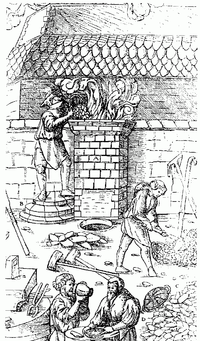
Photo from wikipedia
Abstract The development of oppida in the late first millennium BC across north-western Europe represents a major change in settlement form and social organisation. The construction of extensive earthwork systems,… Click to show full abstract
Abstract The development of oppida in the late first millennium BC across north-western Europe represents a major change in settlement form and social organisation. The construction of extensive earthwork systems, the presence of nucleated settlement areas, long-distance trade links and the development of hierarchical societies have been evidenced. These imply that changes in the style and organisation of agriculture would have been required to support these proto-urban population centres. Hypotheses of the subsistence bases of these settlements, ranging from a reliance on surplus arable production from local rural settlements, to an emphasis on pastoral activities, are here reviewed and grounded against a wider understanding of the expansion of agriculture in the Late Iron Age. These agricultural models have not been previously evaluated. This paper presents archaeobotanical data from six well fills from large-scale excavations at Late Iron Age and Early Roman Silchester, a Late Iron Age territorial oppidum and subsequent Roman civitas capital located in central-southern Britain. This is the first large-scale study of waterlogged plant macrofossils from within a settlement area of an oppidum. Waterlogged plant macrofossils were studied from a series of wells within the settlement. An assessment of taphonomy, considering stratigraphic and contextual information, is reported, followed by an analysis of the diverse assemblages of the plant remains through univariate analysis. Key results evidence animal stabling, flax cultivation, hay meadow management and the use of heathland resources. The staple crops cultivated and consumed at Late Iron Age and Early Roman Silchester are consistent with those cultivated in the wider region, whilst a range of imported fruits and flavourings were also present. The adoption of new oil crops and new grassland management shows that agricultural innovations were associated with foddering for animals rather than providing food for the proto-urban population. The evidence from Silchester is compared with other archaeobotanical datasets from oppida in Europe in order to identify key trends in agricultural change.
Journal Title: Quaternary International
Year Published: 2017
Link to full text (if available)
Share on Social Media: Sign Up to like & get
recommendations!